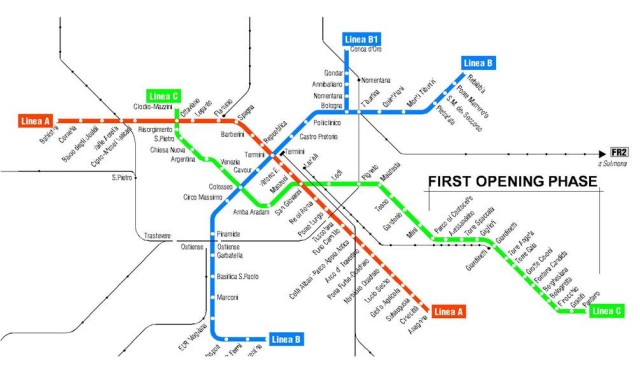The Metro C – a work (very, very slowly) in progress
 Well, I hope you all have a lot of patience (and a lot of lifetime left) because the latest reports say that the Coliseum metro station that will allow the new Rome subway C line (see the Green line above) to bring people to the Roman Forums and to intersect with the older B line will not be ready until….What? Yep, 2021. This is according to the CEO of Roma Metropolitane, Paolo Omodeo Salé who on Friday, May 22, illustrated the current building schedule to a government commission. The opening of the centrally-situated station, which will bring the newest of Rome’s three subway lines close to the historic center (the stop after will be Piazza Venezia) had originally been forecast for September 2020.
Well, I hope you all have a lot of patience (and a lot of lifetime left) because the latest reports say that the Coliseum metro station that will allow the new Rome subway C line (see the Green line above) to bring people to the Roman Forums and to intersect with the older B line will not be ready until….What? Yep, 2021. This is according to the CEO of Roma Metropolitane, Paolo Omodeo Salé who on Friday, May 22, illustrated the current building schedule to a government commission. The opening of the centrally-situated station, which will bring the newest of Rome’s three subway lines close to the historic center (the stop after will be Piazza Venezia) had originally been forecast for September 2020.
No one who knows Rome would/should be surprised by this. Subway construction, which means digging underground, is a painfully slow process in the Eternal City, where thousands of years of history have left countless ruins, some important, some less so, but few that city authorities feel comfortable about sacrificing. This is one reason that the subway network is so limited compared to cities like Paris and London and why so many Romans use motorbikes to get around. (For example, no subway comes to my area, Trastevere, and none is planned. This is fine with me. We already have too many kids coming here for evening thrills and, increasingly, too many tourists. But it is odd in a major city.)
Add to the obstacles posed by history’s remains, other typical Roman things such as graft, resulting court cases, unrealistic bids, strikes, other legal actions, political infighting and the general inefficiency that characterizes life here, and delay after delay can come as no shocker. Just think, the C line, the third of Rome’s subway lines, was originally planned for completion in time for the Roman Catholic Jubilee in the year 2000!
Construction on the C line finally began in 2007 and miraculously part of the system became operational only seven years later, last November 9, when driverless Breda carriages began shooting along among the 15-stations stretch between Monte Compatri Pantano on the city’s eastern Casilina road and Parco di Centocelle further westward. Work has begin on another nine stations, six of which were opened to the public for viewing on April 30 and which are (supposed) to become operational sometime in June or July. Next year, they say, the station at San Giovanni may be completed (I don’t believe it) and after that work will push ahead to Amba Aradam and then the Coliseum.
Furthermore, the entire section that will cross the historic center is still only a vision in some engineer’s beleaguered brain and at the moment there is talk that the stops originally foreseen for inside the centro storico – Piazza Argentina and Chiesa Nuova – may be eliminated. In other words, from Piazza Venezia the trains would run directly to the other side of the Tiber River.
The final length of the line is supposed to be 25,6 km (although it may be extended to Piazza Clodio where the city’s courthouse stands. But I’m betting there is no way this will be done by 2024, when Rome is hoping to host the Olympics. Anyone want to bet on completion before 2030? Not me.
The delays also mean that costs now amount to 3.7 billion euros with 70% paid for by the state, 18 % by the city of Rome and 12% by the Lazio Region. And this doesn’t include the toughest part; laying the track through downtown Rome, which some say could bring the entire cost to something like 6 billion euros or the equivalent of 234 million Euros per kilometer, compared to the European average of 120-150. Oy gevalt, as many of my fellow New Yorkers would put it.


